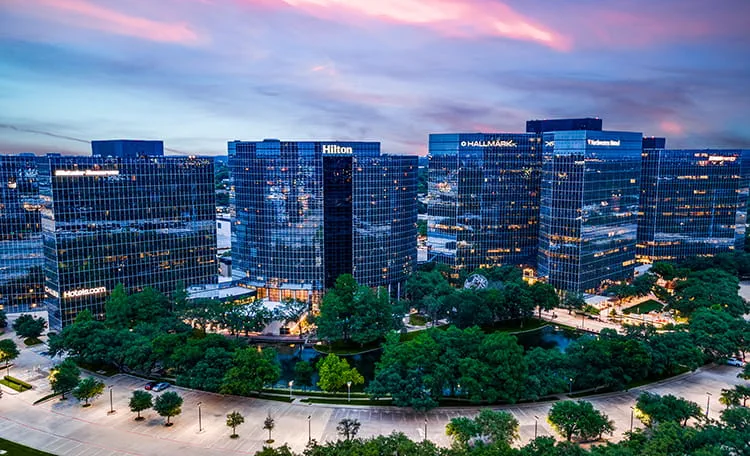
Early in the pandemic, many questioned the role of the office and whether the unforeseen global experiment in remote working would render the office irrelevant. Now, as we find ourselves in the third year of a global pandemic, we are gaining a greater sense of the long-term impact.
With hybrid working seemingly entrenched in work-life across most of the globe, Asia Pacific isn’t seeing the same response, with much of its workforce instead heading back into the office. In fact, the Asia Pacific office market has shown continued resilience throughout this pandemic, being the only region to record consecutive quarters of positive net absorption since the virus’ onset, and the forecast for office demand continues to look positive largely due to the three following factors: growth in office-based employment, weaker adoption of flexible working practices and the vital role the office continues to fulfill.
GROWTH IN OFFICE-BASED EMPLOYMENT
Unemployment forecasts show that labor markets are expected to tighten across the region, with most registering unemployment rates at or below their respective five-year averages. However, aggregate figures of unemployment hide finer details highlighted in the ‘K-shaped’ recovery that has already revealed weakness in retail, tourism and service-oriented sectors compared to tight labor conditions in professional services, IT, finance and manufacturing. There is an increasing mismatch between required business skills and the available labor force which has intensified the war for talent. Beyond this, evidence from a global study shows that 41% of the workforce is considering changing jobs within the next 12 months—during the so-called ‘Great Resignation.’ While this originated in the U.S., there is mounting evidence that it will also sweep through parts of Asia Pacific. Fundamentally, the key message here is that corporate occupiers should prioritize talent retention and attraction in the immediate term as well as enhancing productivity through investment in technology and real estate. Unemployment forecasts out to 2025 suggest that unemployment will stabilize around the same levels forecasted towards the end of 2022.
Furthermore, office employment across Asia Pacific is forecast to grow at more than twice the rate of total employment at 2.1% per annum and 0.8% per annum respectively. The mismatch is especially stark in mainland China as employment moves up the value chain and greater proportions of workers enter office-based employment. In absolute terms, office-based employment is forecast to increase by more than 12 million workers by the end of 2025, with the majority accounted for by growth in mainland China and India.
WEAKER ADOPTION OF FLEXIBLE WORKING PRACTICES IN ASIA PACIFIC
There has never been a time when workplace strategy has been so extensively discussed while so closely scrutinized. The global experiment of working from home during lockdowns has accelerated the adoption of greater flexible working practices for many corporations. However, uncertainty reigns regarding the optimal blend of in-office and remote working.
Analysis of data from Cushman & Wakefield’s bespoke workplace strategy tool, Experience per Square FootTM (XSF), has shown a practically universal desire to work more flexibly post-pandemic, but significant variations exist across the region. At one end of the spectrum, employees in mainland China and India still prefer to spend most of their work time in the office, while in Australia there is a greater desire to adopt a hybrid model that incorporates more remote working. The data highlights that the most important element is to allow employees the freedom to choose where they wish to work. If employers can then inspire their staff back into the office, not only does this provide a boost to employee experience but also drives significantly higher engagement outcomes.
Globally, because employees expect greater choice of where to work, office spaces will be increasingly designed with a greater focus on collaborative space. But the shift in Asia Pacific is likely to be more limited. Fundamentally, this is due to a greater proportion of employees spending more time in the office and therefore requiring space for focused work. As a result, occupiers will likely turn to landlords to provide collaborative space and wellness activities elsewhere within the building for group use.
THE OFFICE CONTINUES TO FULFILL A VITAL ROLE
The office continues to play a vital role in the workplace, so the key is understanding what is needed from the office and by whom. Throughout the pandemic, workers have shown that they can continue to be productive when working from home. However, this has come at the expense of other aspects of workplace experience. For example, employees who joined their company within the previous year are doing well, outscoring longer-tenured colleagues on over 70% of XSF measures, but remote work has been a drag on personal interaction—especially when it comes to building professional networks and bonding with colleagues.1 In contrast, mi tenured employees (3-5 years tenure) appear to be struggling the most with working from home and see the greatest improvements with more frequent office attendance.2
The challenge for landlords and occupiers is how to inspire employees to choose the office. In simple terms, it will mean creating great spaces and places—placemaking—as employees will expect and require more than an A-grade building with great views. The office is an essential tool in retaining and recruiting talent and communicates a company’s brand and culture. Amenities are now key differentiators, evolving into spaces for tenants to work, socialize and connect with colleagues. Creating communities is now fundamental to the tenant experience and at the heart of a thriving precinct, building or workplace. Consequently, we see communities being created through wellness spaces, tenant apps, partnerships and events.
REMARKABLE RESILIENCE
The Asia Pacific office market has shown continued resilience, being the only region to record consecutive quarters of positive net absorption since the onset of the pandemic. Although the near-term economic outlook has become a little more uncertain since the start of the year, office demand is expected to remain robust. Office demand for the full year in 2021 across Asia Pacific’s top 25 markets rebounded to 64 million square feet (msf), which is 60% above 2020 levels. This is due to record demand in Tier 1 markets in mainland China. Demand is expected to increase further to 72 msf—reflective of a stronger recovery and office employment growth across the entire region—before returning to pre-pandemic levels of around 83 msf in 2023. Projected employment growth and the transition to a higher proportion of office-based employment are forecast to more than offset the underlying headwinds from remote working.
With corporates placing a greater emphasis on building quality and amenities, the nature of demand will shift. Inevitably, this will favor newer, higher-grade assets with lower-grade assets, especially those for which refurbishment is financially unviable, potentially becoming obsolete. To an extent, this is to Asia Pacific’s advantage with its comparatively young average prime building age. However, risk aversion and supply chain disruptions have meant that building supply pipelines have been pared back with new supply in 2022-23 being below the 2015 19 average in 60% of markets tracked across the region. Against this backdrop, the office in Asia Pacific is far from dead and corporate occupiers will need to be increasingly proactive in deciding their space requirements in light of increasing demand for quality space at a time of more limited supply.
Read the full article.






